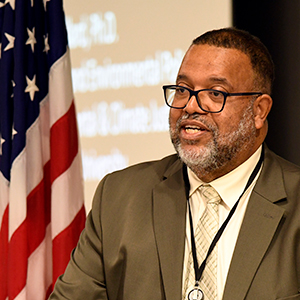Research investments in ribonucleic acid (RNA) modifications led to the development of the COVID-19 vaccines, saving millions of lives worldwide and capturing the 2023 Nobel Prize in Physiology or Medicine. Now, NIEHS has co-sponsored a new report from a 16-member committee of the National Academies of Sciences, Engineering, and Medicine (NASEM) that reminds us of the critical role the RNA molecule plays in life processes. The report provides a roadmap for sequencing RNA with all its modifications that will help usher in a new era for health and medicine and other sectors, including agriculture, where it can help increase crop productivity.

“Identifying, mapping, and sequencing all RNAs and their modifications is as ambitious and as important as mapping the human genome, but even more challenging,” said Fred Tyson, Ph.D., the NIEHS program lead for this topic. Unlike DNA, which does not travel in a cell, RNA has to pass genetic information from the DNA to all the places in the body that need it, and every strand of RNA can get edited or modified, creating vast diversity.
“There are 170 known modifications to RNA, but we think there are plenty more,” said Brenda Bass, Ph.D., NASEM Committee co-chair during the March 21 public webinar releasing the report. Bass is a distinguished professor in the department of biochemistry at the University of Utah. “I feel this is a natural and important next step from the Human Genome Project.”
NASEM Report: Sequencing RNA, modifications
NIEHS, the National Human Genome Research Institute (NHGRI), and the Warren Alpert Foundation, a nonprofit organization that provides grants and scholarships to conduct research to cure diseases, sponsored the report. NIEHS funding for the report came from the Office of the Director.

The report includes six chapters, a summary, appendices, and roadmaps for milestones ranging from five to 15 years. There are key recommendations made in the report, including calling for the National Institutes of Health (NIH) and others to strategically invest in and prioritize closing research gaps, establishing an oversight body to coordinate a large-scale public and private initiative, advancing technology and developing standards for sequencing, and cultivating a strong skilled workforce.
Four conclusions outlining the future of the research field are listed in the report.
- RNA modifications are a critical but underexplored area of research.
- Enabling the determination of any epitranscriptome (the sequence of a set of RNA molecules and their modifications) will be the most impactful goal.
- Large-scale, coordinated efforts in the life sciences have been vital in driving science and technology innovation.
- A large-scale epitranscriptomics effort is needed to accelerate technological innovation and progress in the field.
Building the foundational science
NIEHS has been growing its portfolio related to RNA sequencing and epitranscriptomics research for years, but more needs to be done to develop the technology to advance the field, Tyson offered.
“The way we are doing the actual RNA sequencing now is not really accurate,” he explained. “We are sequencing cDNA, or complementary DNA, and removing the modifications. Having actual RNA sequences and modifications will really help our research looking at environmental diseases and increase our ability to do predictive analysis.”
The need to develop more innovative technologies was one of the items brought out during a workshop led by NIEHS and NHGRI in May 2022. That workshop, which addressed current capabilities in the field and identified research needs, set the stage for the new NASEM report.
“The new NASEM report goes far beyond the earlier workshop, but both call for innovations in science,” Tyson said. “It’s an ambitious, expensive 15-year plan, but if other agencies, academia, industry, and others join with NIH, the possibilities for public health, agriculture, biodefense, and other disciplines are endless.”
Next steps for NIEHS and NIH
NIEHS researchers are continuing to work to learn more about modified RNAs and epitranscriptomic processes related to adverse health outcomes, including cancers, metabolic disorders, and neurodevelopmental effects. Others at NIH are also supporting research on RNA sequencing and investing in technology development.

NIEHS and NHGRI lead an NIH-wide working group that includes more than a dozen institutes and centers. Tyson said the group is about to embark on a comprehensive assessment across NIH to capture current work, share successes and lessons learned, and identify what NIH can bring to the table to be part of the large-scale effort called for by NASEM and the science.
(Robin Mackar is a writer and media relations coordinator in the NIEHS Office of Communications and Public Liaison.)









